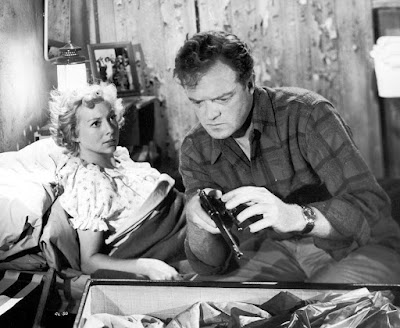This tolerable—only sixty-one minutes—film opens with a driving, big band score by Albert Glasser, the king of B-movie composers. Against automobile headlights cutting through night streets, there are interesting title designs giving one the feeling of a cutting-edge crime drama. I was relieved that “The Beast With...” is absent from the title. The lobby poster might have you believe this is a science fiction movie. A misleading movie title to be sure, but 20,000 seemed to be a popular round number during this era and flows better than 37,000 or the like. The dialogue is well memorized, always on cue, and disappointing.
Singer and hoofer, Gene Nelson, tries again to step out of his musical background with another crime movie. He is not unique enough to notice and arrives late to the noir party. Nelson is in the spotlight right from the first scene. Though a legit diamond mine investor, he needs capital to cover a failing mine in Brazil. He swindles rotund John Banner’s investment money to do it. Banner feeds Nelson a knuckle sandwich as his introduction to the movie. Nelson intends to pay him back but he needs time. Much more than the five days Banner gives him. The poor sound quality coupled with Banner’s thick German accent and fading volume make it difficult to understand his every word. I could have used subtitles.
Merry Anders plays Nelson’s secretary and girlfriend. To help with Nelson’s predicament, they contact Nelson’s old Army buddy and mining partner—Anders’s old flame—James Brown. Brown brings some diamond samples at Nelson’s request as promotional investments. His plan involves stealing valuable diamonds from a museum and returning them after an appropriate appraisal. With a lot of persuading they both help make the theft a success. Nelson (his stunt double) sneaking across rooftops and into the museum before dawn is a nice touch. It has the momentary feeling of a high-quality caper. It continues so dark one cannot see Nelson’s time-consuming detail work he goes through to steal the diamonds from the museum case. Unless one has stolen jewels before from a case with alarms, you will have no idea what he is doing. I think he may have done a super professional job (for his first time) but we will never know for sure what he did exactly. But the director sure devoted a lot of film to it.
It is easy to lose track of which diamonds were samples, switched, stolen, stolen again or returned in Nelson’s shell game. His meeting with diamond appraisers is interrupted by Brown disguised as a robber. In the planned struggle with Brown’s gun, Nelson is supposed to take a bullet in the arm. Also part of the plan is a prior injection of Novocain into Nelson’s forearm so he does not feel the bullet as much. I have never tried that. I assume it stops the bleeding as well.
In the director’s attempt to explain away the logic behind the theft, Robert Shayne is given a useless part as the police lieutenant who tries to piece together Brown’s presence at the bank. The whole scene, filmed with the echo of an area microphone, lasts less than two minutes. Everyone gives contradicting remarks about the bandit’s identity and reasons for him arriving at that precise moment. Shayne is stumped, gives up, and is the last we see of him.
The phony theft of the diamonds means Nelson’s insurance policy will pay off. But it will take six weeks to get the money returned to Banner. Nelson pays Banner a visit poolside with his twenty-two-inch television console nearby. After Nelson’s attempt to explain, Banner threatens Nelson, who pushes Banner backward into the pool, tipping over the console on the way down. Never mix electricity and chlorine.
Note: This B-movie has the qualifying attributes. Dark filters for night scenes. Abrupt editing. Many interior scenes were filmed with an area microphone. Showing Nelson in his 1961 Chrysler pulling curbside a few times at the same location supplements the film’s location action and cements a low budget. The music score, so promising at the beginning, inserts itself in some scenes as if the composer never saw the rushes. Except for the poor lighting, questionable script and directing, it may likely satisfy an hour, however.















